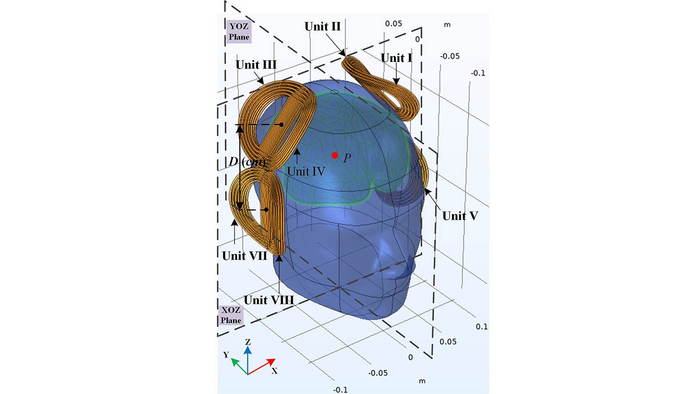WASHINGTON, Nov. 29, 2022 – As a noninvasive neuromodulation method, transcranial magnetic stimulation (TMS) shows great potential to treat a range of mental and psychiatric diseases, including major depression.

Credit: Xiao Fang
WASHINGTON, Nov. 29, 2022 – As a noninvasive neuromodulation method, transcranial magnetic stimulation (TMS) shows great potential to treat a range of mental and psychiatric diseases, including major depression.
Stimulating the deep brain helps researchers explore the causes of and possible treatments for psychiatric diseases, but current methods don’t go quite deep enough and are largely restricted to superficial targets within the brain.
In AIP Advances, from AIP Publishing, a group of researchers in China from Chengdu University of Technology and Huazhong University of Science and Technology present a new TMS array with a special geometrical-shaped magnet structure to help stimulate deeper tissue within the brain.
“Considering the approximate spherical structure of the human head, I wondered if special-shaped coils could be more advantageous than flat coils,” said Xiao Fang, a co-author who has worked on TMS for nearly eight years. “When I was studying at Wuhan National High Magnetic Field Center in 2016, we had a magnet design department in our lab, and they did some research regarding special-shaped magnets for electromagnetic shaping. After seeing their research posters, it inspired us to try to use shaped magnets in bioelectromagnetic stimulation.”
Inside the brain, external stimuli transmit information through neurons with electrical and chemical signals.
“Deep brain stimulation taps into the penetrating ability of an electromagnetic field or signal to target the membrane potential of deep brain neurons and change the polarization or depolarization effect to achieve neuromodulation,” said Fang.
The group’s new spatially symmetric array, based on a curved type of coil, offers advantages over traditional TMS coils in deep brain stimulation performance.
“It enables focalized stimulation within the deep brain so fewer untargeted tissues are exposed to strong stimulation,” said Fang. “And the location of the stimulation target generated by the array can be flexibly and continuously adjusted.”
This array’s special geometric design enables deep brain focused stimulation 11 centimeters below the scalp.
“That is 1.67 times deeper than conventional planar stimulation arrays when producing the same focusing area, which effectively improves the stimulation effect,” Fang said.
The group’s design is mainly intended for deep brain stimulation, such as the treatment of major depression, and its target area is the ventromedial prefrontal cortex region located 7 centimeters beneath the human scalp.
###
The article, “Noninvasive focalized stimulation in deep brain using the spatially symmetric array,” is authored by Xiao Fang, Chen Yun, Chaoxu Zeng, Hongfa Ding, Yongheng Huang, Wi Liu, and Yaoyao Luo. It will appear in AIP Advances on Nov. 29, 2022 (DOI: 10.1063/5.0121692). After that date, it can be accessed at https://aip.scitation.org/doi/10.1063/5.0121692.
ABOUT THE JOURNAL
AIP Advances is an open access journal publishing in all areas of physical sciences—applied, theoretical, and experimental. The inclusive scope of AIP Advances makes it an essential outlet for scientists across the physical sciences. See https://aip.scitation.org/journal/adv.
###
Journal
AIP Advances
DOI
10.1063/5.0121692
Method of Research
Experimental study
Article Title
Noninvasive focalized stimulation in deep brain using the spatially symmetric array
Article Publication Date
29-Nov-2022




